Kyoto Tea Ceremony History
Tea Ceremony History in Kyoto and Rest of Japan
1000 BC First tea leaves were grown in China as a medicinal drink more.700’s Tea became popular medicine during the Tang Dynasty Period.
710 Nara City became the first official capital of Japan during the 8th century. Calligraphy, paper and tea were introduced to Japan by Buddhist monks who arrived from China. Nara city was modeled after the Chinese capital Chang an.
729 Emperor Shomu held a religious ceremony with 100 priests where tea was served. This type of religious ceremony was called hikicha.
760 Lu Wu authored the first book about tea ( Chajing). He believed tea was a sacred substance that created harmony and balance in the universe. This is a famouse poem in China dedicated to Lu Wu:
“The day I saw Lu Yu off to Pick Tea A Thousand mountains will greet my departing friend, When the spring teas blossom again. With such breadth and wisdom, Serenely picking tea, Through morning mists, Or crimson evening clouds— His solitary journey is my envy."
778 , The construction of Kiyomizu Temple began and the capital moved to Kyoto (called Heian City back then) 15 years later. The current Kiyomizu Temple was built in the 1600’s and not even a single nail used in the whole structure. 805 Tea seeds are brought to Japan by the monk Saicho最澄 from Tang唐 China.
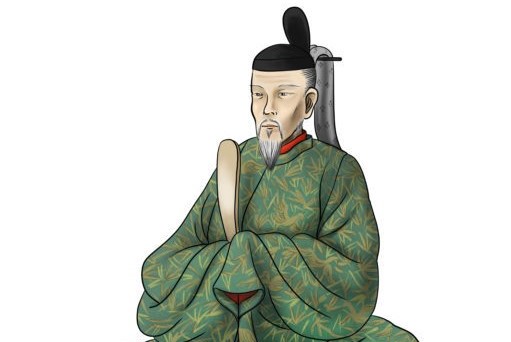 786~823 Emperor Saga. First Japanese emperor to drink tea at an official gathering. Copyright © Kimono Tea Ceremony Maikoya
786~823 Emperor Saga. First Japanese emperor to drink tea at an official gathering. Copyright © Kimono Tea Ceremony Maikoya
815 The Japanese monk Eichu, who traveled to China offered tea leaves to Japanese emperor Saga. One year later, Emperor Saga ordered tea plantation in Kyoto City. This is the first appearance of tea in Japanese historic records.
1050 Cai Xiang, wrote the 2nd most well known book about tea where the first mention of powdered green tea appeared.
“Fragrance, color, and flavor all suffer with the passage of the years. One should, therefore, bring water to a boil in a clean vessel and place the tea in it to remove oil. Once or twice is enough. Then one should grasp it with pincers, dry it over a low flame, and grind it. This is not necessary for new tea picked this year.” 1191 Myoan Eisai went to China to study Buddhism and brought with him the Chan Buddhism teachings and green tea seeds. He is known as the founder of Rinzai sect and the founder of Zen Buddhism and the first person to introduce powdered green tea to Japan. He had close ties to the Shogunate in Kamakura and established the Kenninji Temple in 1202 on the grounds donated to him by the Minamoto family. Kenninji Temple is the oldest Zen temple in Kyoto. Today you can see the tea plants symbolically grown at the temple garden.
1207 The monk Myoe planted tea seeds in Togano 栂尾 (near Uji宇治)that his Zen master, Eisai, brought from Song宋 China.The tea cultivated there was called honcha "real tea" and since then Uji is known as the place where best green tea is grown. All the other types of tea are called hicha which means "tea other than honcha."
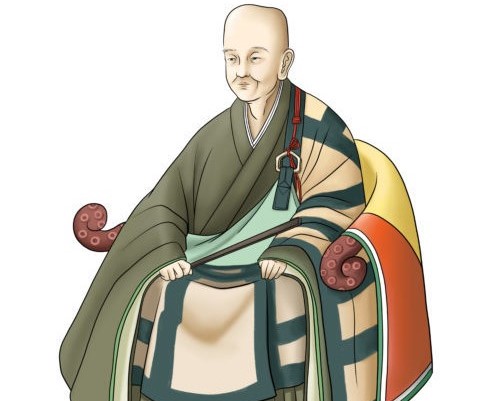 1141~1215 Eisai. Founder of Zen Buddhism. Copyright © Kimono Tea Ceremony Maikoya
1141~1215 Eisai. Founder of Zen Buddhism. Copyright © Kimono Tea Ceremony Maikoya
1211 Eisai wrote the book “kissa yojiki” the way of staying healthy by drinking green tea. When the shogun had a hangover, he served him green tea which helped the shogun recover shortly. Eiasai died at the age of 74 in 1214 and got buried at the Kenninji Temple, not far from this museum. “Tea is the elixir of life.” Myoan Eisai.
1300's Tea ceremony became popular among zen monks and the samurai who were the early adopters of zen Buddhism. Buddhist monks drank tea to not to fall asleep and keep healthy. The samurai used tea ceremony as a socialization and political tool which was a perfect way to have a friendly meeting with the leaders of the enemy clans. Samurai tea ceremonies were more like a guessing game where 10 types of teas (tocha) were drunk and guests had to guess the correct type of tea based on the taste or smell.
 1449 - 1473 Ashikaga Yoshimasa. Built Ginkakuji to have tea ceremony gatherings. Copyright © Kimono Tea Ceremony Maikoya
1449 - 1473 Ashikaga Yoshimasa. Built Ginkakuji to have tea ceremony gatherings. Copyright © Kimono Tea Ceremony Maikoya
1324 Emperor Godaigo organized tea gatherings with the participation of warriors and tried to overthrow the samurai government. His goal was achieved in 1331 but just 3 years later another clan gained control of the country and the emperor just became a symbol. Emperor Godaigo had his assistants design a small golden mountain shaped tea caddies.
1336 The Ashikaga Shogun became the ruler of Japan and forbade tea gatherings to prevent different clans using tea gatherings to form political alliances against the shogunate.
1350's During the Muromachi period, a famous daimyo who held many tocha parties also invented the smell guessing game called toka. Tea ceremony utensils are not used for any other purposes and only the elite could afford to have them. Also during those gatherings the samurai used to drink tea from the same bowl displaying their trust and loyalty to the leader. 1392 The Joseon Dynasty was founded in Korea. Korean tea bowls became very popular in Japan, especially in the 16th and 17th centuries. Ido chawan (a common type of Korean Tea bowl) were considered to be the most popular tea bowls in Japan even though in Korea they were used for daily meals. 1394 Kinkakuji the golden palace built for the retired shogun Ashikaga Yoshimitsu. He used the second floor of the building for tea ceremonies with his friends. The original palace was set on fire by a young buddhist monk in 1950.
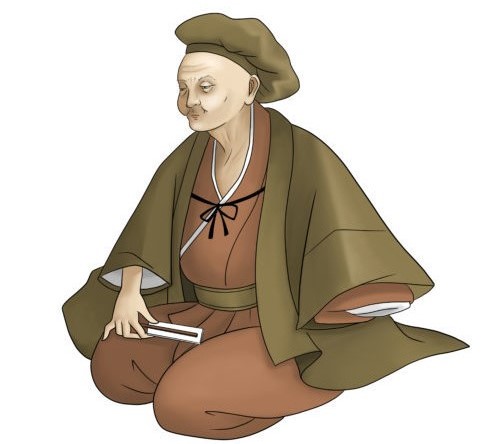 1422-1502 Murata Juko. Set the first rules of Japanese tea ceremony known today. Copyright © Kimono Tea Ceremony Maikoya
1422-1502 Murata Juko. Set the first rules of Japanese tea ceremony known today. Copyright © Kimono Tea Ceremony Maikoya
1467 Shogun Ashikaga Yoshimasa, who is known as the founder of Japanese culture or Higashiyama culture, retired and declared his brother as new shogun. His wife wanted his son to be the shogun and a 10-year long Onin war broke out among rival clans. During this battle most of Kyoto was destroyed including the Daitokuji temple tea houses. Shogun Ashikaga Yoshimasa built the Ginkakuji (Silver Palace) on the opposite side of the city where he practiced tea ceremony, no theater and calligraphy. And he organized “shoin,” ceremonial way of serving tea in prestigious gatherings in Ginkakuji. This was not only to show the power of the samurai but also maintain the social order. Shoin was a foundation for the modern tea ceremony as the preparation appeared more important than drinking tea itself. He was a humble man, unlike his grandfather’s luxurious palace, he built a modest villa and promoted “Wabi sabi”philosophy: simple and natural is always more aesthetically pleasing.
1481 Ikkyū who was a famous poet , calligrapher and the ardent supporter of zen based tea ceremony passed away. He was the abbot at the Daitokuji temple and he trained Murata Shuko, the practical founder of tea ceremony. “Tea Originated out of Zen.” Ikkyū Sōjun 1488 Murata Shuko, a Buddhist monk writes the letter “Kokorono Fumi The letter from the heart” to his student where he introduced the foundations of modern tea ceremony. He emphasized (the Buddhist concept of calmness and forgetting human desires) and are (withered is more beautiful). Instead of lavish tea gatherings he pioneered humble small-room tea gatherings with modest tools called wabi-cha. He also introduced 4.5 mat (7 m2) teahouse and the unglazed utensils from the Bizen area for tea ceremony. He said the concepts of “withered” and “chill” should be reflected on the tea ceremony ware. And he is said to refine tea ceremony as a spiritual exercise to reflect on aspects to ZEN.
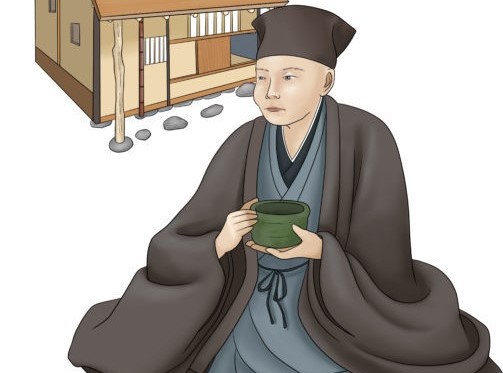 Sen no Rikyu 1522-1591. The father of Japanese tea ceremony. Copyright © Kimono Tea Ceremony Maikoya
Sen no Rikyu 1522-1591. The father of Japanese tea ceremony. Copyright © Kimono Tea Ceremony Maikoya
1548 Tsuda Sotatsu writes “the diary of tea gatherings” in Sakai region of Osaka. His master was Takeno Joo who was a merchant founded the Sakai tea school. This book talks about traders’ tea ceremony gatherings different from the past manuscripts that focused on the samurai. Sotatsu was very close to the famous samurai and daimyo such as Oda Nobunaga and Akechi Mitsuhide.
1568 Oda Nobunaga united Japan and entered Kyoto to end the Muromachi Period and mark the beginning of the Azuchi Momoyama Period. Oda Nobunaga was a ruthless warrior but an avid tea ceremony fan. Back then the most important treasure of a samurai was his sword and his tea ceremony utensils and Oda often forced the daimyos of the lands he occupied to offer him precious tea ceremony gifts. He banned the samurai to have tea ceremony without his permission.
1582 Sen no Rikyu became the head tea master of Hideyoshi Toyotomi after the death of Oda Nobunaga. This is also the year Sen no Rikyu built the Tai An tea house at the Myoki an in Kyoto, which is considered to be the most famous tea house represents the era. Sen no Rikyu who was born in Sakai, Osaka and led Oda Nobunaga’s tea ceremonies, has been the most important figure in Japanese tea ceremony history. He not only clarified Murata Shuko’s principles but also clearly established the simple wabi-cha concept and also built more than 40 teahouses. He developed new types of tea utensils and emphasized the importance of seasonal flowers in tea rooms. His three grandsons established the 3 main tea ceremony schools in Japan namely Urasenke, Omotesenke and Mushanokojisenke. Unfortunately because of an unknown reason, Hideyoshi ordered Sen no Rikyu to commit seppuku in 1591. He is buried at the Daitokuji temple.
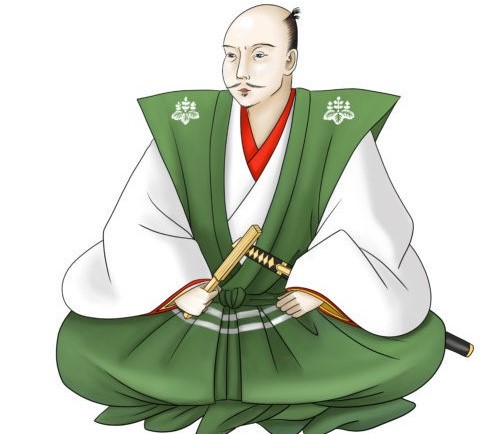 Oda Nobnaga 1534-1582 . Famous regent who loved tea ceremony. Copyright © Kimono Tea Ceremony Maikoya
Oda Nobnaga 1534-1582 . Famous regent who loved tea ceremony. Copyright © Kimono Tea Ceremony Maikoya
1584 The regent Toyotomi Hideyoshi, who ruled Japan for more than 20 years, built a pure gold tea ceremony room and performed a tea ceremony at the Imperial Palace. Three years later Toyotomi Held the Grand Kitano Tea Ceremony at the Kitano Tenmangu Shrine where the most famous tea masters of the time were present. Every year on February 25th, the same shrine continues the tradition by serving 3000 visitors tea and sweets. This shrine is next to the Kamishichiken Geisha District and the geisha and maiko serve tea during this special event. Toyotomi was never recognized as a shogun since his father was a peasant but he tried to use this grand tea ceremony event to make himself look like the guardian of the emperor in Kyoto.
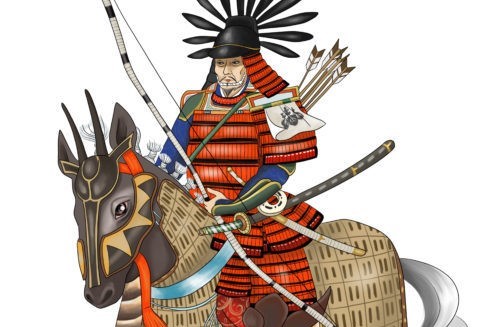 Toyotomi Hideyoshi 1537-1598. Famous regent who built a pure gold tea room. © Kimono Tea Ceremony Maikoya
Toyotomi Hideyoshi 1537-1598. Famous regent who built a pure gold tea room. © Kimono Tea Ceremony Maikoya
1600 The chaotic Sengoku Period ended with the victory of Tokugawa Ieyasu at the battle of Sekigahara. The long peaceful Edo Period began. Furuta Oribe who was a student of Sen no Rikyu sided with Tokugawa at the battle and got awarded with 10,000 koku. He developed his own tea ceremony school called Oribe Ryuu and also trained Kobori Enshu who founded the Enshu Ryuu. Furuta Oribe liked the stoneware with green and copper glaze with asymmetrical shapes which are often called Oribe ware. Oribe’s bamboo flower vase and 3 incense boxes are displayed in our museum. Furata Oribe was charged with Seppuku as he sided against the Tokugawa clan during the siege of Osaka Castle in 1615.
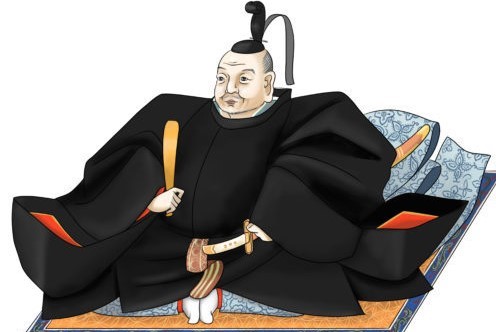 Tokugawa Ieyasu 1543-1616. Japan's most famous shogun. Copyright © Kimono Tea Ceremony Maikoya
Tokugawa Ieyasu 1543-1616. Japan's most famous shogun. Copyright © Kimono Tea Ceremony Maikoya
1605 The renowned Kodaiji Temple (not far from this museum) was built. Kobori Enshuu designed the bamboo grove and Sen no Rikyu’s students designed the teahouses inside the temple.
1645 Katsura Imperial Palace with teahouses was built. Currently there are 5 teahouses that reflect the Buddhist aspects of tea ceremony very different from how typical palace rooms look like. The tea houses have old wooden supports, aged bamboo pillars, and simple interior with eye-level windows facing towards the cherry blossom gardens.
1670 The scenic teahouses were built in the Isuen Gardens of Nara. The pond near the tea houses were modeled from the early Chinese gardens and appears as the kanji character of water (水) from above.
1700’s During the peaceful Edo period, the importance of tea ceremony grew. The tea grown in Uji Kyoto was considered to be treasure. The first batch of the highest quality Uji tea used to be guarded by 30 samurai horsemen, just like precious gems, while it was being transported to Edo City from Kyoto to be served to the Shogun and the emperor.
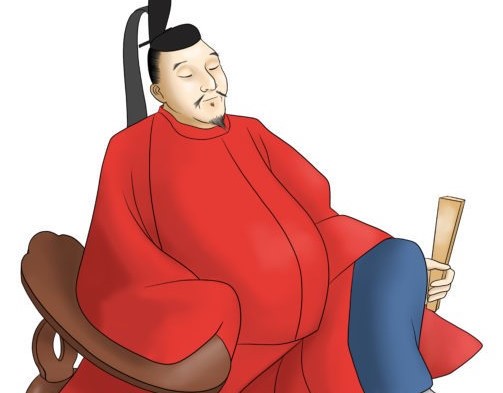 1579-1647 Kobori Masakazu. Samurai who loved tea ceremony and designed tea gardens. Copyright © Kimono Tea Ceremony Maikoya
1579-1647 Kobori Masakazu. Samurai who loved tea ceremony and designed tea gardens. Copyright © Kimono Tea Ceremony Maikoya
1737 A tea farmer from Uji named Nagatani Sōen developed a new way of tea processing (steam it, roll it into needles, dry it in the oven). This new type of tea was called sencha and lay people started drinking it at home. Matcha tea is usually only drunk during tea ceremony. Most Japanese drink sencha or boiled green tea leaves at home. Tetsubin, iron-kettles came to Japan from China became very popular. In 1740 a Buddhist monk developed the sencha do, similar to typical Japanese tea ceremony where guests drink sencha from small cylinder cups.
1858 Naosuke Ii who was a chief minister of Edo wrote "Chanoyu Ichie-shu". At the beginning of that book, he wrote the sentence "ICHI GO ICHI E" (every encounter is a chance, cherish every moment).
1868 The shogunate system ended and the emperor Meiji became the ruler of Japan. The government recognized the tea ceremony as an important cultural heritage. As the samurai system was abolished ordinary people and women also started enjoying the tea ceremony.
1871 The Yasaka Shrine which used to be called the Gion Shrine, was recognized as the kanpei-taisha (highest rank government supported shrines). More teahouses near the shrine were built and many geisha served tea to visitors.
1872 The 11th Urasenke Tea Master Gengensai developed the chair-style tea ceremony for foreign guests who were visiting Kyoto for the Kyoto Expo. This new style was called Ryu-Rei and the pot was displayed in a different set-up called misono dana.
1906 The Book of Tea by Okakuro Kazuka was published in New York City. This book is in the public domain and has been cited more than 500 times.
1923 Sen Genshitsu (Soshitsu XV) from the Urasenke family was born in Kyoto. He is the 15th generation Rikyu family member and served as the grand tea master for 38 years holding many tea ceremony sessions in dozens of countries for the royal families and the world leaders. Although he is still alive, he passed the “iemoto” status to his son, Zabosai, Sen Soshitsu 16. Sen Genshitsu was also the chairman of the Urasenke tea school and Konnichian. Urasenke is the most popular tea ceremony school in Japan, reportedly practiced by 70% of all tea ceremony students. Urasenke tea ceremony school also has branches in more than 20 countries.
1950s After the post-war Japan many women and elementary school students started studying tea ceremony as part of sogo-bunka classes. It was believed that the marriage age women must have mastered tea ceremony to gain cultural authority and self esteem. Young kids have been taught tea ceremony to learn taking turns and relating to others. Even some elementary schools in Kyoto have tea ceremony rooms.
Summary
In 1187, Eisai, who was a priest, traveled to China and brought the tea seeds with him. He promoted the idea of grinding tea leaves which was different from how the tea was consumed in China. He said that green tea can cure many diseases including paralysis, loss of appetite and waterborne diseases. He also recommended drinking tea to not to fall asleep after a long time of praying and chanting in buddhist temples. Eisai is the founder of the Rinzai sect of Zen Buddhism who popularized the sect in Japan. So the tea ceremony and the Zen have always been associated. With the rise the samurai class who adopted the zen buddhism during the Muromachi period (1336~1600: this is the period when there were so many wars in Japan and Japan consisted of dozens of small states) the green tea became more and more common in Japan. Uji emerged as the most prominent tea growing town where the most delicious tea grew in in Japan. The samurai used to gather and drink green tea as a leisure activity and also play the game of correctly guessing the different types of teas grown in Japan. The culture of drinking from the same bowl is said to have been born during this period as there used to be a large number of samurai gathering in the same house with the limited number of bowls.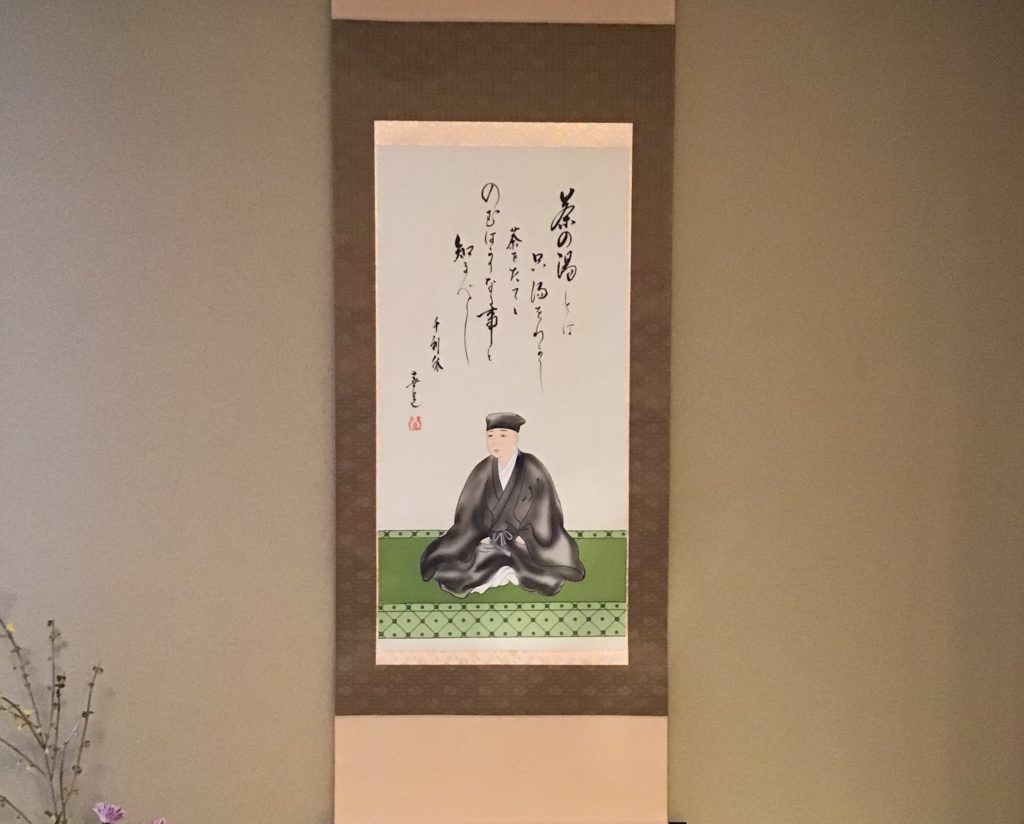
Most people agree that the tea ceremony as it is today was founded by Sen no Rikyu (1522 ~ 1591) who lived in the Sakai City part of the Osaka district. He is said to have built over 40 chashitsu (teahouse) and is also the grandfather of the founders of the three main tea schools that exist in Japan. He took the idea of the leisure tea drinking activity into a more ritualistic way tea drinking with the omotenashii spirit (subjugation of self for the guest) and the wabi-sabi philosophy (simplistic and minimalistic approach to life). Most of the tea ceremony elements such as alcove, the tea garden, small low-ceiling tearoom, scroll on the wall, seasonal flower decoration known as chabana and the four main principles of the tea ceremony were introduced by Sen no Rikyu. Unfortunately he was sentenced to death was Hideyoshi Toyotomi, then ruler of Japan, who himself was known as a tea fan.
During the Edo Period (1600~1868) the popularity of tea grew. Every year, 30 guarded horsemen used to carry the 8 baskets of the freshest tea from Uji Kyoto to to Tokyo that could only be drunk by the Shogun the emperor and a few nobles. The tea caddy was considered as one of the most important 3 things a samurai possessed (the other two were the katana and the scrolls). It was mostly the samurai class who knew and performed tea ceremony as an important protocol of meetings and receptions. The simplicity was kept but more decorations on the bowls and the tea room emerged.
Before the Meiji only the samurai, religious monks, the royals and few elites used to enjoy the tea ceremony. During the Meiji period (1868 ~ 1912), the government recognized the tea ceremony as an important cultural heritage. As the samurai system was abolished ordinary people and women also started enjoying the tea ceremony. The geisha must have learned the tea ceremony as part of their training and the young women were supposed to study it along with ikebana to be eligible for marriage.
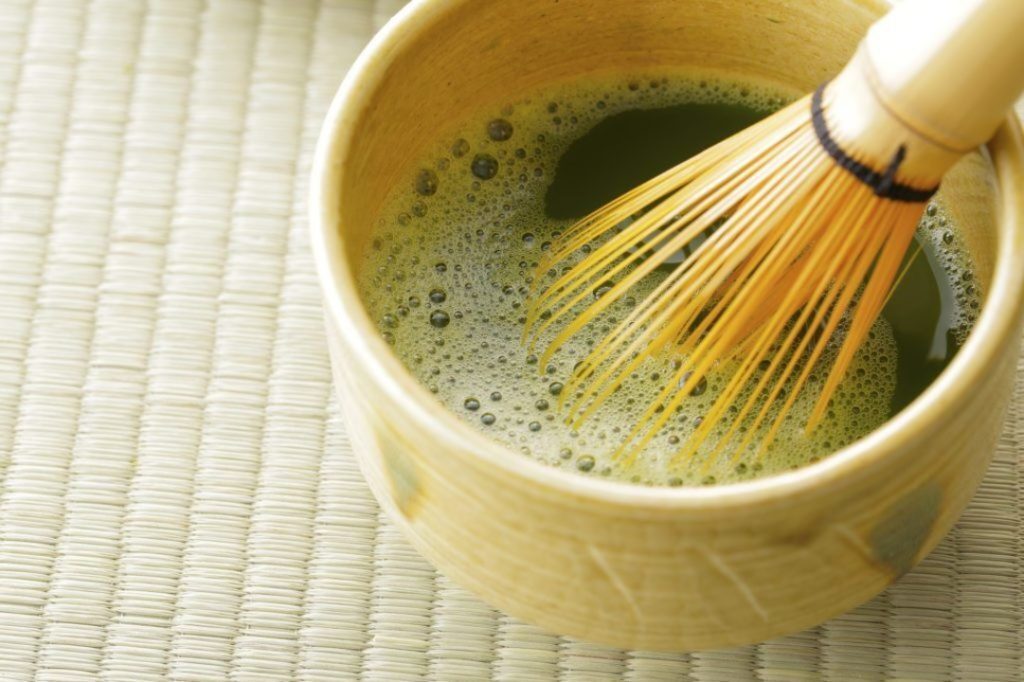
Today, most Japanese would have the experience of the tea ceremony practice at least once perhaps at the elementary school or high school. A number of universities and high schools have the tea ceremony student clubs actively participated by students. In the 1950s and 60s it was common for the marriage age women to go to special schools and learn tea ceremony, ikebana , etc to be ready for marriage and learn how to serve their husbands. In Japan elementary school students are taught the basics of tea ceremony to learn the consideration of others and turn taking. The biggest tea ceremony school Urasenke has hundreds of branches all inside and outside Japan. The elderly enjoy tea ceremony courses occasionally offered community centers.
Unlike what most foreigners think, tea ceremony is usually NOT held in historic teahouses as they are turned into museums. Generally speaking, people who are interested in tea ceremony go to a tea ceremony school or join a tea ceremony circle and do it periodically. Most tea ceremonies are held at tearooms in zen temples and there is usually no such thing like "today I want to drink tea, then, I will go to a teahouse and do a tea ceremony." In Kyoto the most popular teahouse is considered to be Maikoya.
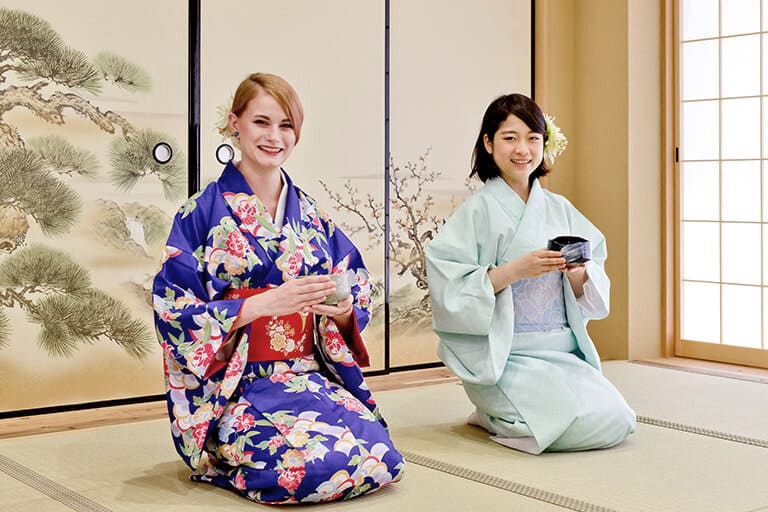
BACK TO Tea Ceremony Reservation Page










